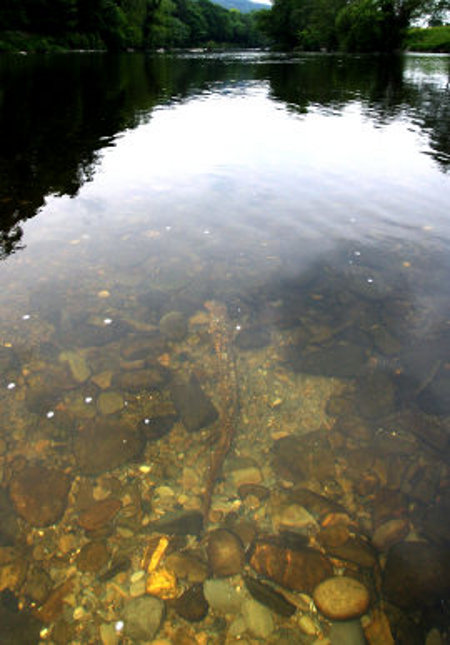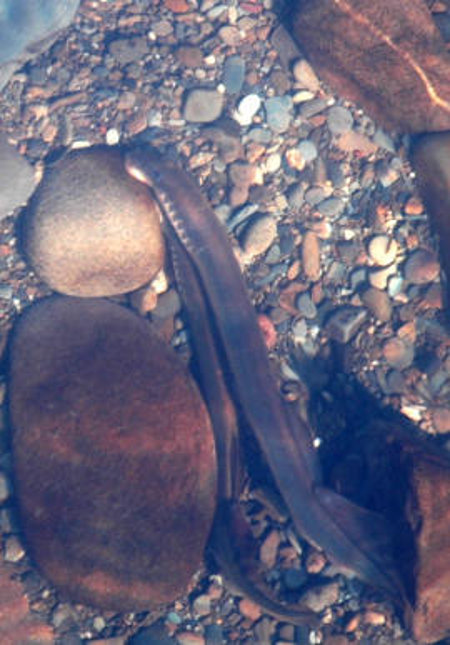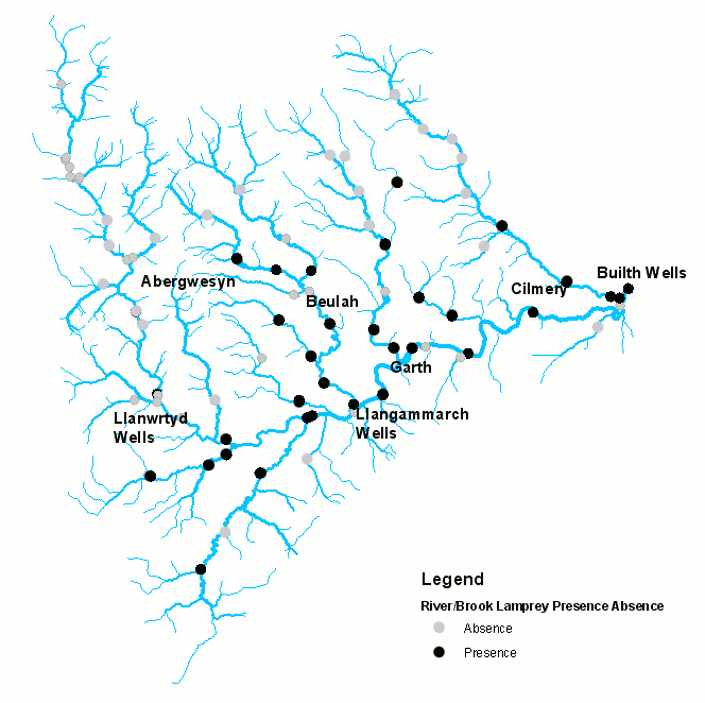

The Lampreys
Sea Lamprey (Petromyzon marinus)
The sea lamprey is a primitive, jawless fish resembling an eel. It is the largest of the lampreys found in the UK. It occurs in estuaries and easily accessible rivers, and is an anadromous species (i.e. spawning in freshwater but completing its life cycle in the sea). Like the other species of lamprey, sea lampreys need clean gravel for spawning and marginal silt or sand for the burrowing juvenile form, which are called ammocoetes. Features such as weirs and dams, as well as polluted sections of river, may impede migration to spawning grounds. In comparison to River lamprey sea lampreys seem to be relatively poor at ascending obstacles to migration.
The species occurs in estuaries and easily accessible rivers over much of the Atlantic coastal area of western and northern Europe (from northern Norway to the western Mediterranean) and eastern North America. It has declined in some parts of its European range. In UK rivers it is reasonably widespread. In some places it is still common, but it has declined in parts of its UK range and has become extinct in a number of rivers. It appears to reach its northern limit of distribution in Scotland and does not occur north of the Great Glen.
River Lamprey (Lampetra fluviatilis) and
Brook Lamprey (Lampetra planeri)
There is increasing evidence that river and brook lamprey are actually the same species and simply represent two different life strategies, (as in sea trout and brown trout). The 'river lamprey' is the anadromous form (spawns in freshwater but migrates to sea to live). Pollution and obstacles such as weirs or dams impede migration. There are a few land-locked populations, including one in Scotland which is considered as having special European importance. River lamprey are found only in Western Europe, where it has a wide distribution from southern Norway to the western Mediterranean. They are widespread in the UK, occurring in many rivers from the Great Glen in Scotland southwards. UK populations are strong and are considered important for the conservation of the species at an EU level.
The 'brook lamprey' is now believed to represents the life strategy that stays in freshwater and does not feed once it has metamorphosed from the juvenille ammoceote into the eel like adult form. It also requires clean gravel to spawn in and marginal silt and sands for the ammoceotes.
Brook lamprey populations have declined in some parts of its European range, including parts of the UK, although it is still widespread. This species is the most abundant and widespread of the British lampreys and is often found in the absence of the other two species, for example above a barrier that precludes the presence of the migratory species. It is common in many areas of England but is absent from much of Scotland north of the Great Glen, including Orkney and Shetland and all but a few of the Western Isles.
What ISAC will do for Lampreys
Sea lamprey is the only species currently deemed to be in favourable conservation status within the Wye SAC, which has one of the healthiest populations of this species in the UK and provides exceptional quality habitat in the main stem of the Wye. In the Irfon the population is confined to the main stem below Llanwrtyd Wells and the lower reaches of the larger tributaries. The ISAC project helped maintain this status.
Brook and River lamprey Lampetra planeri and fluviatilis are present in the main Irfon below Llanwrtyd Wells and also spawn in the tributaries. The UK populations of these two subspecies are deemed worthy of conservation in a European context. The range of the resident form (brook) is expected to expand further due to the acid amelioration work.

The in-channel improvements that will be carried out in ISAC will have the most significant impact on the Lampreys. In sections of river where the natural geomorphology is severely damaged, populations have been assisted through a variety of processes, including :
-
Roughening of banks with timber, creating marginal silt deposits needed by the juvenile stage
-
The establishment of natural pool/riffle sequences assisted by the addition of and fixing of coarse woody debris (CWD)
-
Construction of high water refugia
This work will be targeted at creating extra ammoceote habitat for all three species of lamprey, resulting in an expected increase in numbers of fluviatilis/planeri by at least 2,500 and the knock on downstream improvements to Petromyzon marinus are estimated to result in a minimum of 100 extra returning adults.
